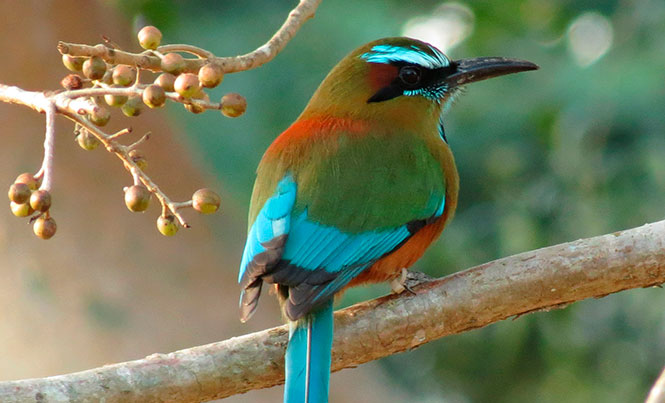
While most birds are busy building nests high up in the trees, the turquoise-browed motmot can be found burrowing long tunnels in an earth bank, quarry or cave where it will prepare a hideaway nursery. It will lay 3-6 white eggs which hatch in 17-20 days, and both parents participate in the tunneling, building the nest, incubating and attending the young once they hatch. This bird is one of the smallest motmots, approximately 34 cm long and only 65 grams, but one of the most handsome birds in the tropics.
Turquoise-browed motmots have a radiant plumage of olive green, orange and blue flight feathers. Their distinct brilliant turquoise eyebrows appears to be reflective in the dark. They also boast a black mask around their eyes and a distinct extra long tail which resembles that of a badminton birdie. The tail has two bare shafts and feathered tips which they wag back and forth like the pendulum of a clock.
Studies show that the tail display of male and female turquoise-browed motmots is likely a form of communication with predators, to let them know they are aware of their presence in the hope that the predator will not waste its time with a chase. The tail wagging is also a mating signal performed by male birds.
They are a monomorphic species meaning there are no obvious differences between the genders. It is not clear if their fluffed-up eyebrows are displayed to attract a mate or a sign of feeling threatened, possibly both. The have a wide, curved bill with finely serrated edges that provides a firm grip on their prey as they typically kill it by smashing it against a hard surface. With a sharp sense of sight, they are very swift and can snatch their prey in midair.
The bird inhabits Central America, South America, and parts of Mexico, mainly in the Yucatan. The motmot is the national bird of El Salvador and Nicaragua. Motmots eat snakes, small reptiles, bees, dragonflies, other insects, and fruit. It is not on an endangered list, but with continued destruction of their habitat, they and all other wildlife is at risk.